Fiat Money Always Dies

In this article:
Almost everyone in the world today still uses fiat currency to measure their wealth. Even if their money is tied up in precious metals, property, or stocks, they still value those assets in dollars, along with any calculations they make about their net worth. This way of thinking is so ingrained that even most Bitcoiners still measure the value of everything in dollars, including their Bitcoin.

This behaviour is to be expected. After all, money is the tool we use to measure and agree on the value of things. The problem is, the tool we’re currently using has become irreparably broken. Fiat money is being debased so quickly that prices are increasing at an accelerated rate every year.
If this process of debasement continues, and it will, then we will eventually reach a point where prices aren’t just rising every year, but every day. If you were upset about egg prices going up every few months, you might want to prepare yourself for a world where they increase every few hours.

It sounds ludicrous, but it’s not without precedent. During a particularly severe episode of hyperinflation in Argentina between 1989 and 1990, annual inflation reached a peak of over 20,000%. In this environment, businesses were forced to reprice goods as often as every 4 hours, and prices skyrocketed into the billions or trillions in the old austral currency. As you might expect, it caused absolute mayhem.
A lot of people live under the impression that the dollar could never face such a calamity. It’s the world’s reserve currency, backed by the world’s current leading superpower. Surely what happened in Argentina could never happen in the US?

What happened in Argentina isn’t an anomaly; it’s the norm. Fiat money ALWAYS dies regardless of who issues it—even if that issuer is a world superpower. In this week’s newsletter, let’s read through some of those obituaries to make the case that the death of the dollar isn’t just likely, it’s inevitable.
The Graveyard of Fiat Currencies
The best way to understand why all fiat currencies are doomed is to explore their history. Since the 1700s, over 775 fiat currencies have collapsed. All of them eventually falling victim to hyperinflation, war, or corruption and mismanagement.

History shows that currency failures are not random accidents; they always follow a predictable pattern. Governments discover they can print money to solve their short-term problems, they then become addicted to this ‘easy fix’, and repeat it until they completely destroy the value of their own currency. It’s a tale as old as time.
Let’s look through some examples…
Ancient Rome
Rome was one of the greatest empires the world has ever seen, but few appreciate just how large a role currency debasement played in its eventual collapse.
Romans traded in a currency known as the denarius. It weighed around 4.5 grams and was trusted all across Rome’s sprawling empire because it was made from almost 100% pure silver. This sound money facilitated trade and helped Rome to conquer, expand, and trade their way across the Mediterranean.
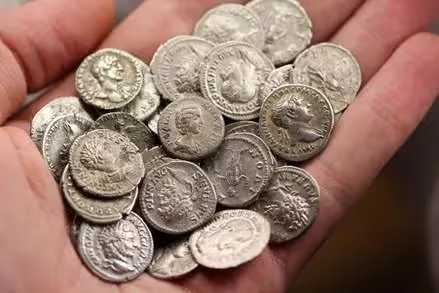
Rome would become unfathomably wealthy, bringing in vast riches from territories like Carthage, Greece, Spain, and Dacia, flooding the city with silver, gold, slaves, and exotic goods. But as the empire grew, so did Rome’s extravagance.
Rome descended into opulence and complacency. The elite led extravagant lifestyles of unencumbered luxury while emperors squandered imperial fortunes on personal whims and public spectacles. Prosperity’s corrupting effects began to erode the civic virtues that built Rome, as those charged with its stewardship succumbed to greed, lust, and decadence.

Before long, the ballooning and increasingly complex Roman Empire was unable to extract enough wealth from its occupied regions to fund endless wars, critical infrastructure, and keep up with the insatiable hunger of Rome herself. The empire was living beyond its means.
As you might expect, Rome did not opt to return to financial discipline to solve its problems. Instead, successive emperors began debasing the currency to plug the hole in their deficits. They melted down existing coins, added base metals like copper, and reminted them at the same face value.
By the time of Emperor Gallienus in the 3rd century AD, the silver content had plummeted to less than 5%, and the coin's weight was halved. The result? Hyperinflation gripped the empire. Prices for basic goods like wheat surged 1,000× in just a few decades, merchants refused debased coins and bartered instead, and soldiers demanded higher pay in real silver.

This economic chaos weakened Rome, contributing to invasions and the empire's eventual split and fall in the West by 476 AD.
China’s Song Dynasty
Where was paper money invented?

Paper money first emerged in China during the Tang dynasty in the 7th century as a form of merchant-issued promissory note known as "flying money," to help facilitate large transactions without using heavy coins. By the 11th century, it had evolved into true government-issued paper currency called “jiaozi” under the Song dynasty (960–1279 AD).
The invention of paper money in China addressed a pressing practical problem: the cumbersome weight of traditional copper, iron, and bronze coins. As the economy boomed with increased trade, agriculture, and urbanization, merchants found themselves struggling to transport large quantities of heavy coins to facilitate transactions. Paper notes, being lighter and more portable, significantly reduced the physical burden of monetary exchange.

Initially, paper money brought significant benefits. Jiaozi, issued by merchants and later regulated by the state, enabled credit expansion, frontier provisioning for armies, and international trade with regions like Korea and Southeast Asia. By 1127, the government had decided to issue a standardized paper currency, backed by silver, called “huizi” notes that had expiration dates to prevent over-circulation.
Unfortunately, in typical fiat currency fashion, fiscal pressures eventually led to currency debasement. Facing constant military threats with wars against the Jin and later the Mongols, the government was forced to overprint notes to fund defenses, tributes, and an enormous army. Without sufficient metallic reserves, the huizi notes became unbacked, and by the 13th century, emperors like Lizong had abolished expiration dates, flooding the market with paper promises.

This overissuance triggered hyperinflation. Huizi depreciated rapidly until they became practically worthless as public trust evaporated. Prices soared, savings were eroded, and trade was disrupted, eventually leading to social unrest among merchants and peasants.
Just like Rome, currency debasement played a pivotal role in the Song dynasty's collapse. The economic instability caused by currency debasement weakened the government's ability to finance military campaigns or pay tributes, making them vulnerable to Mongol invasions led by Kublai Khan. The paper currency system collapsed in 1264, and by 1279, the Southern Song fell to the Yuan Dynasty. What began as a clever solution to logistical woes ended in fiscal ruin, illustrating how unchecked fiat monetary expansion can undermine an entire empire's foundations.
The Rise and Fall of World Reserve Currencies
Let’s move on from ancient examples of currency debasement and fast forward to the emergence of world reserve currencies.
World reserve currencies are the dominant forms of money used globally for trade, debt settlement, and storing value at any given time and rise to prominence alongside a nation's economic power. History shows, however, that their dominance typically only lasts for 80–120 years before declining due to factors like excessive money printing, wars, and shifts in global influence. It turns out no world reserve currency can reign supreme forever.
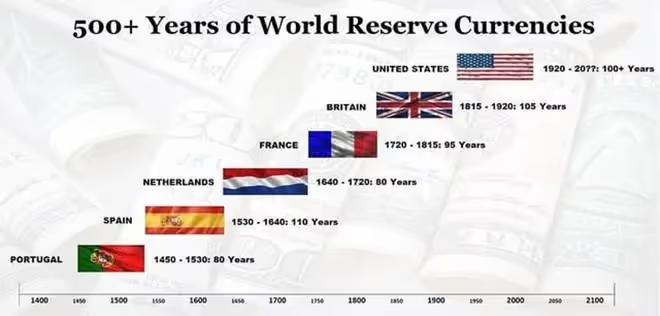
The Portuguese Real
The history of world reserve currencies begins in the 1400s with the Portuguese real. Portugal's Age of Discovery, led by explorers like Vasco da Gama, established vast trade routes to Africa, India, and Brazil.
Spices, gold, and slaves flowed back, making the real the go-to currency for international commerce by the mid-15th century. Its rise stemmed from Portugal's naval dominance and colonial wealth.
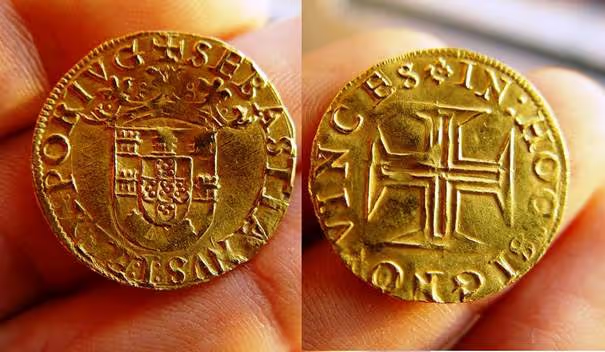
However, by the 1530s, competition from Spain had begun to erode Portugal’s status. Overexpansion, strained resources, and unchecked minting diluted the real's value, eventually leading to inflation and its fall as the world’s reserve currency.
The Spanish Dollar (Real de a Ocho)
The Spanish dollar (or real de a ocho) supplanted the Portuguese real as the world’s reserve currency by around 1530. Fueled by massive silver imports from the Americas, Spain had become Europe's richest empire, and the Spanish dollar's reliability, backed by abundant silver, made it widely accepted, even in Asia.
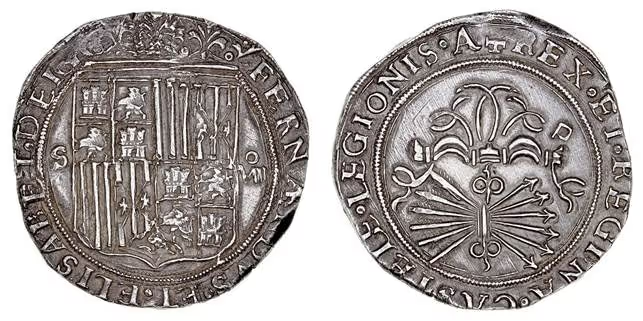
The Spanish Real dominated for over a century, but endless wars, like the ‘Eighty Years' War’, would drain Spain’s treasuries. In response, Spain was forced to debase the Real de a Ocho by mixing in cheaper metals, ultimately destroying its value via debasement.
By the 1640s, economic mismanagement and colonial losses ended the real de a ocho’s reign as the world’s reserve currency, making way for the Dutch guilder to climb to the top spot.
The Dutch Guilder
The Dutch guilder emerged in the 17th century as the Netherlands built a vast trading empire through the Dutch East India Company. Amsterdam quickly became the world's financial hub, and the guilder became widely adopted. The guilder was backed by gold, strong international trade, and prudent monetary policy. This provided the stability that led it to become the world reserve currency until the early 1700s.

The guilder’s decline came from costly wars with England and France, combined with increasing competition in international trade. Like their predecessors, the Dutch turned to monetary expansion to fund their deficits, destroying the value of the guilder and paving the way for the ascendance of the French franc.
The French Franc
France's currency, initially the livre and later the franc, gained reserve status in the early 18th century as the nation solidified its position as Europe's leading power. Under Louis XIV's absolute rule (1643–1715), France built a vast colonial empire spanning North America, the Caribbean, Africa, and India, driving trade in sugar, slaves, and luxury goods. This economic boom, coupled with a large population and advanced manufacturing, made the livre a trusted medium for international settlements, especially in continental Europe.
The currency's peak came during the Napoleonic era (1799–1815), after the French Revolution introduced the franc in 1795. Napoleon backed the franc with a bimetallic standard tied to fixed weights of gold and silver and imposed it across occupied territories from Spain to Russia, facilitating trade and debt within a French-dominated Europe.
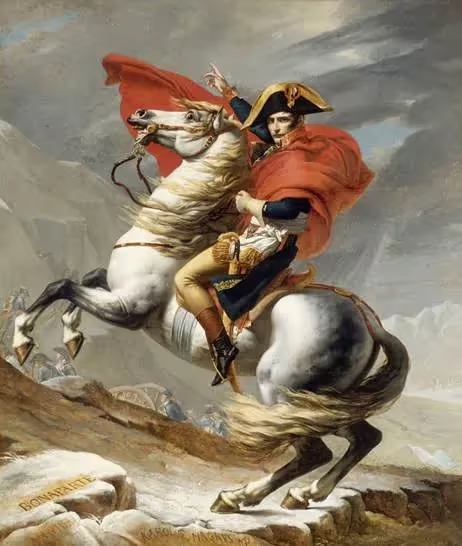
But the franc's downfall was swift, driven by the same forces that doomed prior reserves, namely endless wars and fiscal irresponsibility. Napoleon's exploits had accrued huge debts and defeat at Waterloo in 1815 to the British was the final blow to French dominance that triggered reparations and economic collapse. With France weakened, the British pound quickly supplanted it.
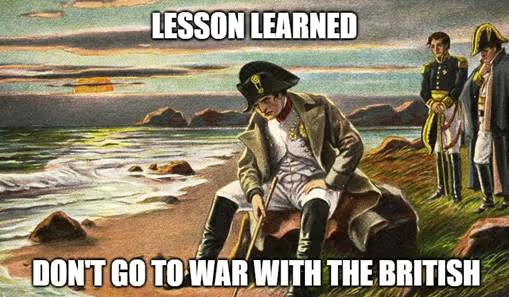
The British Pound
The British pound ascended to world reserve status in the early 19th century, following Britain's triumph in the Napoleonic Wars, which had eliminated French rivalry and ushered in Pax Britannica. The Industrial Revolution then drove explosive economic growth, making the British Empire extremely wealthy and allowing it to expand to cover more than a quarter of the globe. That’s where the saying “the sun never sets on the British Empire” comes from.
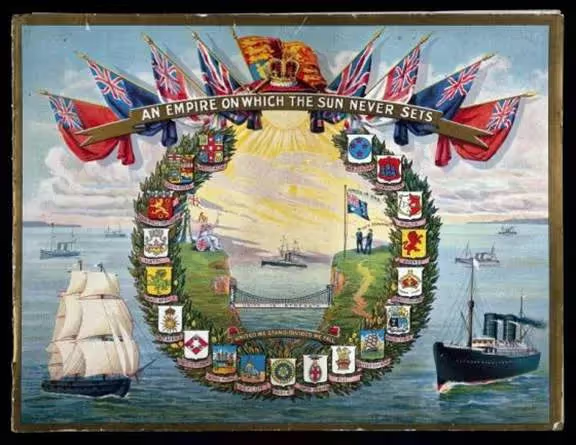
By 1821, Britain had adopted the classical gold standard, fixing the pound to 113 grains of gold, which guaranteed convertibility and low inflation. The strength of the empire, combined with the stability of the pound, established London as the world's banking capital through institutions like the Bank of England.
The pound's dominance reached its peak prior to World War I, supporting about 60% of global trade and funding massive imperial investments. But WWI's huge costs forced Britain to suspend gold convertibility in 1914, allowing unlimited money printing to finance the war. There was a short-lived return to the gold standard in 1925, but it was completely abandoned by 1931.

World War II compounded Britain’s financial problems and ultimately sealed the fate of the pound, as Britain was forced to move away from gold-backed money to fund the war. By 1944, these fiscal overreaches and the huge economic consequences of the war had eroded confidence, letting the U.S. dollar take over as war-ravaged European nations abandoned sound money principles.
The US Dollar
Today, the US Dollar reigns, established post-World War II via the 1944 Bretton Woods Agreement, where it was linked to gold and had all other national currencies pegged to it. America's economic might, military supremacy, and oil trade established it as the world’s reserve currency and today all economic activity is ultimately settled in dollars.
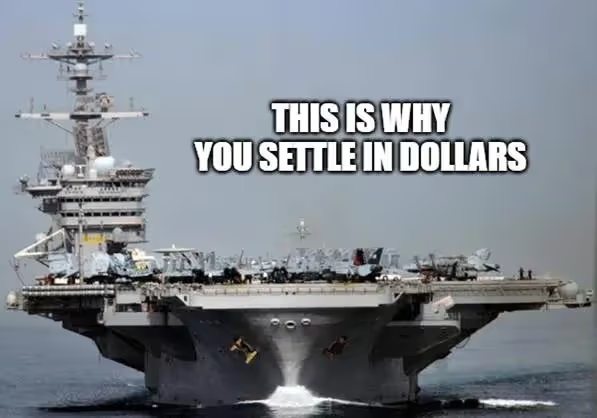
The US dollar might appear unbreakable. It makes up 59% of global reserves, underpins oil trades (the "petrodollar" system), and is the go-to ‘safe haven’ in a crisis. But appearances can be deceptive.
Like its predecessors, the dollar faces serious challenges. In 1971, the ‘Nixon Shock’ severed the dollar’s link to gold, enabling unlimited printing and allowing an unfathomable expansion of the money supply. Since 1913, the dollar has now lost close to 97% of its purchasing power. You would need $32 today to buy what $1 would have bought you back then.

The US government is now over $37 trillion in debt, and the interest payments will soon exceed the revenues collected via taxes. The only way the US can service its growing obligations is by printing more money. It’s either that or default on the debt.
So how long can the dollar’s dominance last?
It’s hard to tell, but history suggests that reserve currencies typically only last for 80 to 100 years. Since the Bretton Woods Agreement, the dollar has been top dog for 81 years now and, given its weakness, predicting its collapse in the next 20 to 50 years isn’t alarmist, it’s just simple pattern recognition.

Bitcoin – Fiat’s Last Funeral
Throughout history, when one world reserve currency fails, another has quickly stepped in to replace it. But this begs an obvious question: when the dollar eventually loses its status as the world’s reserve currency, what will end up replacing it?

Historically, the answer to this question has always been whichever country emerges as the world’s next dominant superpower. But with the advent of Bitcoin, this ongoing cycle looks like it might be coming to an end.
In our increasingly multipolar and confrontational world, every single nation-state is heavily indebted, and all issue currencies that aren’t backed by anything of tangible value. Why, then, would any nation adopt the currency of another when none of them are effective at storing value, and all of them grant their issuer the ability to debase the wealth of everyone else? It doesn’t seem plausible that the US and Russia would be happy to settle trades in the yuan, or that the US and China would ever settle trade using the ruble.

This is where Bitcoin comes into its own. Unlike fiat, Bitcoin can’t be debased, frozen, or sanctioned. By adopting Bitcoin as their reserve currency, nations can trade with one another in a neutral currency controlled by no one that’s completely borderless, transparent, and offers almost instant settlement. It seems obvious that Bitcoin would end up becoming the preferred choice.
Bitcoin won’t just organise the dollar’s funeral. It will cremate fiat currencies entirely.

Prepare For the End of Fiat – The Bitcoin Way
Nation-states will understandably be reluctant to give up their ability to create money. It’s the main source of their power and influence, and most governments will be foolish enough to cling to it until the bitter end and go down with the ship.
But that doesn’t mean you have to join them.
You already suffer the constant erosion of your purchasing power through your government’s wanton use of the money printer and exist in a financial panopticon that robs you of any semblance of financial privacy or sovereignty. So why not adopt Bitcoin and jump in the lifeboat now?

The only thing between you and becoming financially free is taking the time to understand how Bitcoin works, how to secure it and how to transact in it. Our experts can help you gain that knowledge in just a matter of weeks. Book a free 30-minute call with us today and start using the world reserve currency of tomorrow, today.
